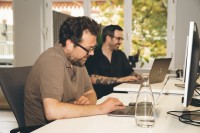Escaping the System Trap
200 Zeichen Lorem ipsum dolor sit amet, consectetuer adipiscing elit. Aenean commodo ligula eget dolor. Aenean massa. Cum sociis natoque penatibus et magnis dis parturient montes, nascetur ridiculus mus. Donec quu.
Kim Notz
15. October 2024
Over the past decades, digitalization has made marketing highly technological while massively increasing its complexity — with corresponding effects on costs. But have brands actually gained from this? All too often, the marketing tech stack feels like a kind of tax, an extra surcharge on operating costs. Lots of expense, little real progress.
And now, the next big wave is rolling in: generative AI. Will complexity and costs rise once again, reaching an entirely new level? Possibly — the danger is real. On the other hand, AI also comes with the promise of reducing complexity and costs through automation. But how, and where, should the marketer — already under pressure from budgets and efficiency demands — even begin if they want to automate campaign processes?
This is clearly a consulting challenge, because there are no easy answers. It’s not about whether consultancies or agencies make the better advisors. What matters is the level of seniority brought to the table. The field is changing at breathtaking speed, and both the topic and the technology are complex.
At first glance, the goal of using AI-driven marketing automation to cut costs and free up resources for new investment seems obvious. But it’s also about scrutinizing and streamlining the entire marketing system. Because despite all the digital promises of measurability, the old adage still applies to many activities: half of all advertising spend is wasted — we just don’t know which half.
Distinguishing one from the other again requires seniority. The entire customer journey — from first activation to e-commerce and conversion, through customer service, loyalty, CRM, and beyond — is complex. Even if we create great products and compelling communication, we still need to think about the system underneath. And at the center of that system are people: end customers, and the marketing professionals tasked with running it.
The Soul and the System of the Brand
What’s needed here is systemic consulting, because marketing processes themselves change once we start envisioning different solutions and using different technologies. The combination of three pillars — the soul of the brand, the system of the brand, and systemic consulting — forms the value proposition of OH-SO Digital. Pia Schott and Axel Averdung, members of the leadership team at the agency founded in March 2024, shared their perspective on marketing, technology, and the role of agencies in episode #122.
At the top of their list is giving agency culture real value — treating it as a source of impact and a key success factor. For Pia, trust replaces rigid processes and rules — trust that people will do the right thing. Alongside their shared vision of culture and the excitement of a new venture came the realization that there is indeed a space for a new kind of agency: one that integrates digital and marketing from the very beginning. For OH-SO Digital, it’s about solutions that are technologically cutting-edge while staying deeply connected to brand values, brand promises, and authenticity.
More than 60 percent of digital features are barely used or not used at all, and over 90 percent of content goes unread — filler in the truest sense of the word. Agencies and tech-enthusiastic CMOs alike run the risk of becoming prisoners of the very systems they’ve created. At a certain point, these systems devour enormous amounts of time, attention, and budget just to keep running — without being rethought, without taking a strategic, long-term perspective, and without setting a new course. This problem mirrors the opposite extreme: CMOs so deeply entrenched in their brand and campaign world that they fail to think broadly enough about digital opportunities.
Excitement in Every Pixel
Technology must never be an end in itself — least of all in marketing. As Axel puts it, every pixel should exist to spark excitement. That’s the reason we go into agencies each morning: to build something together — whether in products, e-commerce, or communications — that carries real value and meaning. OH-SO Digital allows itself a touch of irony, hinted at in the agency’s very name when pronounced in English. Cynicism, however, is something they reject. Fake it till you make it? That’s not their way.
Generative AI has pushed the possibilities for fakery to new extremes. In the digital world, it is becoming increasingly difficult to distinguish between what is genuine and what is fabricated. And the old mantra from the early days of computer science still applies to AI: garbage in, garbage out. What we feed into AI is exactly what comes back out. Setting up and operating AI correctly is far from simple. Anyone who wants to use AI for customer experiences or marketing automation must know precisely what they are doing. And once again, this is where consulting expertise and seniority come into play.
Lorem ipsum dolor sit amet, adipiscing elit.
Of course, seniority can’t be everything. No agency can function without juniors — not economically, not when it comes to scaling, and certainly not with an eye on the medium- and long-term future. After all, tomorrow’s and the day after tomorrow’s seniors have to come from somewhere. Still, the value creation of agencies is closely tied to experience and advisory strength.
It’s no coincidence that CMOs — as mentioned in this very podcast — explicitly wish for “more brains at the table.” And they’re prepared to pay higher fees for that. But this only works if, in parallel, projects delegate junior or even offshore resources where appropriate, in order to address price sensitivity. Without a network — in OH-SO Digital’s case, WPP — such scaling would not be possible at the desired pace.
The charm of a new agency lies in the fact that it carries no baggage: no history, no entrenched structures, no legacy staff. In established agencies, careers often lead to heavy structures and, in some constellations, politics — leaving little room for the real work, the topics and challenges that make the industry exciting in the first place. This brings inefficiencies and wasted value. To change that, the system itself — the cultural dimension — has to be right, with everyone committed to the same goals. That way, the system is able to steer itself more than the structure or bureaucracy behind it.
Find more here:
Kontakt





